Faouzi Bellili
Lens-Type Redirective Intelligent Surfaces for Multi-User MIMO Communication
Jun 01, 2024Abstract:This paper explores the idea of using redirective reconfigurable intelligent surfaces (RedRIS) to overcome many of the challenges associated with the conventional reflective RIS. We develop a framework for jointly optimizing the switching matrix of the lens-type RedRIS ports along with the active precoding matrix at the base station (BS) and the receive scaling factor. A joint non-convex optimization problem is formulated under the minimum mean-square error (MMSE) criterion with the aim to maximize the spectral efficiency of each user. In the single-cell scenario, the optimum active precoding matrix at the multi-antenna BS and the receive scaling factor are found in closed-form by applying Lagrange optimization, while the optimal switching matrix of the lens-type RedRIS is obtained by means of a newly developed alternating optimization algorithm. We then extend the framework to the multi-cell scenario with single-antenna base stations that are aided by the same lens-type RedRIS. We further present two methods for reducing the number of effective connections of the RedRIS ports that result in appreciable overhead savings while enhancing the robustness of the system. The proposed RedRIS-based schemes are gauged against conventional reflective RIS-aided systems under both perfect and imperfect channel state information (CSI). The simulation results show the superiority of the proposed schemes in terms of overall throughput while incurring much less control overhead.
Next-slot OFDM-CSI Prediction: Multi-head Self-attention or State Space Model?
May 17, 2024Abstract:The ongoing fifth-generation (5G) standardization is exploring the use of deep learning (DL) methods to enhance the new radio (NR) interface. Both in academia and industry, researchers are investigating the performance and complexity of multiple DL architecture candidates for specific one-sided and two-sided use cases such as channel state estimation (CSI) feedback, CSI prediction, beam management, and positioning. In this paper, we set focus on the CSI prediction task and study the performance and generalization of the two main DL layers that are being extensively benchmarked within the DL community, namely, multi-head self-attention (MSA) and state-space model (SSM). We train and evaluate MSA and SSM layers to predict the next slot for uplink and downlink communication scenarios over urban microcell (UMi) and urban macrocell (UMa) OFDM 5G channel models. Our numerical results demonstrate that SSMs exhibit better prediction and generalization capabilities than MSAs only for SISO cases. For MIMO scenarios, however, the MSA layer outperforms the SSM one. While both layers represent potential DL architectures for future DL-enabled 5G use cases, the overall investigation of this paper favors MSAs over SSMs.
Channel Estimation for Multicarrier Systems with Tightly-Coupled Broadband Arrays
Apr 15, 2023Abstract:This paper develops a linear minimum mean-square error (LMMSE) channel estimator for single and multicarrier systems that takes advantage of the mutual coupling in antenna arrays. We model the mutual coupling through multiport networks and express the single-user multiple-input multiple-output (MIMO) communication channel in terms of the impedance and scattering parameters of the antenna arrays. We put forward a novel scattering description of the communication channel which requires only the scattering parameters of the arrays as well as the terminated far-field embedded antenna patterns. In multi-antenna single-carrier systems under frequency-flat channels, we show that neglecting the mutual coupling effects leads to inaccurate characterization of the channel and noise correlations. We also extend the analysis to frequency-selective multicarrier channels wherein we further demonstrate that the coupling between the antenna elements within each array increases the number of resolvable channel taps. Standard LMMSE estimators based on existing inaccurate channel models become sub-optimal when applied to the new physically consistent model. We hence develop a new LMMSE estimator that calibrates the coupling and optimally estimates the MIMO channel. It is shown that appropriately accounting for mutual coupling through the developed physically consistent model leads to remarkable performance improvements both in terms of channel estimation accuracy and achievable rate. We demonstrate those gains in a rich-scattering environment using a connected array of slot antennas both at the transmitter and receiver sides.
Domain Generalization in Machine Learning Models for Wireless Communications: Concepts, State-of-the-Art, and Open Issues
Mar 13, 2023



Abstract:Data-driven machine learning (ML) is promoted as one potential technology to be used in next-generations wireless systems. This led to a large body of research work that applies ML techniques to solve problems in different layers of the wireless transmission link. However, most of these applications rely on supervised learning which assumes that the source (training) and target (test) data are independent and identically distributed (i.i.d). This assumption is often violated in the real world due to domain or distribution shifts between the source and the target data. Thus, it is important to ensure that these algorithms generalize to out-of-distribution (OOD) data. In this context, domain generalization (DG) tackles the OOD-related issues by learning models on different and distinct source domains/datasets with generalization capabilities to unseen new domains without additional finetuning. Motivated by the importance of DG requirements for wireless applications, we present a comprehensive overview of the recent developments in DG and the different sources of domain shift. We also summarize the existing DG methods and review their applications in selected wireless communication problems, and conclude with insights and open questions.
Continual Learning-Based MIMO Channel Estimation: A Benchmarking Study
Nov 19, 2022Abstract:With the proliferation of deep learning techniques for wireless communication, several works have adopted learning-based approaches to solve the channel estimation problem. While these methods are usually promoted for their computational efficiency at inference time, their use is restricted to specific stationary training settings in terms of communication system parameters, e.g., signal-to-noise ratio (SNR) and coherence time. Therefore, the performance of these learning-based solutions will degrade when the models are tested on different settings than the ones used for training. This motivates our work in which we investigate continual supervised learning (CL) to mitigate the shortcomings of the current approaches. In particular, we design a set of channel estimation tasks wherein we vary different parameters of the channel model. We focus on Gauss-Markov Rayleigh fading channel estimation to assess the impact of non-stationarity on performance in terms of the mean square error (MSE) criterion. We study a selection of state-of-the-art CL methods and we showcase empirically the importance of catastrophic forgetting in continuously evolving channel settings. Our results demonstrate that the CL algorithms can improve the interference performance in two channel estimation tasks governed by changes in the SNR level and coherence time.
Nonlocal Reconfigurable Intelligent Surfaces for Wireless Communication: Modeling and Physical Layer Aspects
Oct 12, 2022



Abstract:Delivering wireless ultrahigh-speed access at wider coverage is becoming considerably challenging due to the prohibitive investment costs per user and the necessary shift to range-limited millimeter-wave (mmWave) transmissions. Reconfigurable intelligent surfaces (RIS) are expected to extend the reach of mmWave and TeraHz signals more cost-effectively in situations where fiber backhaul and fronthaul are not accessible or infrastructure densification is costly. This paper investigates some challenges facing this technology, particularly in terms of scalability and the question of what type of RIS configurations would be appropriate for mmWave networks and what design strategies can be adopted to optimize the performance and minimize the signaling overhead. We conclude that RIS configurations for the wireless infrastructure likely need to be nonlocal (i.e., redirective, wavefront-selective) rather than local (i.e., reflective) to support communications and networking tasks such as integrated fronthaul and access (IFA) most efficiently.
Super-Wideband Massive MIMO
Aug 02, 2022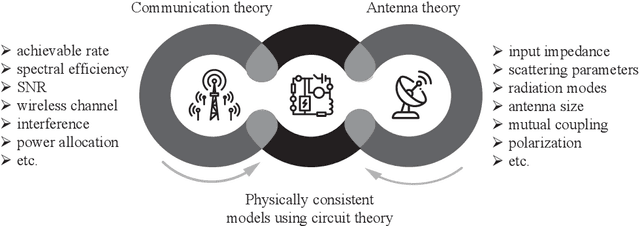
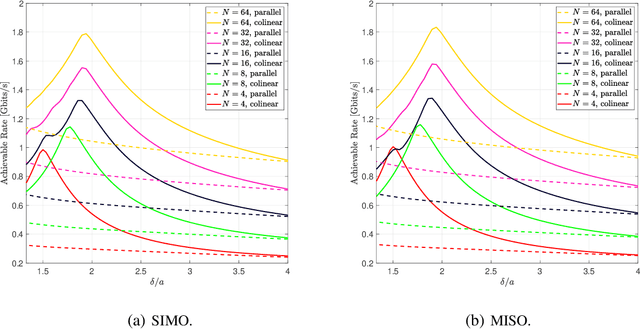

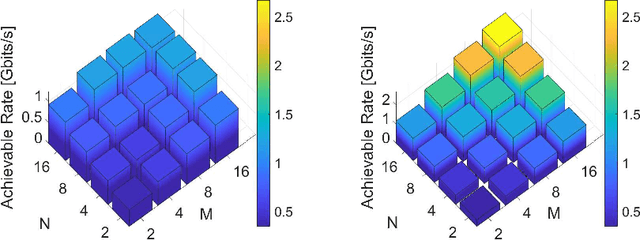
Abstract:We present a unified model for connected antenna arrays with a massive (but finite) number of tightly integrated (i.e., coupled) antennas in a compact space within the context of massive multiple-input multiple-output (MIMO) communication. We refer to this system as tightly-coupled massive MIMO. From an information-theoretic perspective, scaling the design of tightly-coupled massive MIMO systems in terms of the number of antennas, the operational bandwidth, and form factor was not addressed in prior art and hence not clearly understood. We investigate this open research problem using a physically consistent modeling approach for far-field (FF) MIMO communication based on multi-port circuit theory. In doing so, we turn mutual coupling (MC) from a foe to a friend of MIMO systems design, thereby challenging a basic percept in antenna systems engineering that promotes MC mitigation/compensation. We show that tight MC widens the operational bandwidth of antenna arrays thereby unleashing a missing MIMO gain that we coin "bandwidth gain". Furthermore, we derive analytically the asymptotically optimum spacing-to-antenna-size ratio by establishing a condition for tight coupling in the limit of large-size antenna arrays with quasi-continuous apertures. We also optimize the antenna array size while maximizing the achievable rate under fixed transmit power and inter-element spacing. Then, we study the impact of MC on the achievable rate of MIMO systems under light-of-sight (LoS) and Rayleigh fading channels. These results reveal new insights into the design of tightly-coupled massive antenna arrays as opposed to the widely-adopted "disconnected" designs that disregard MC by putting faith in the half-wavelength spacing rule.
Optimizing Binary Symptom Checkers via Approximate Message Passing
Oct 30, 2021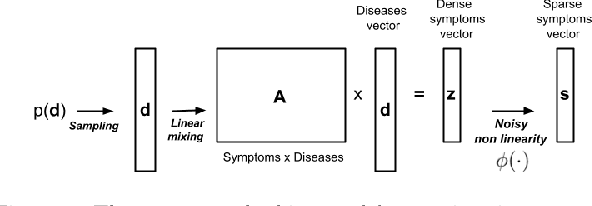
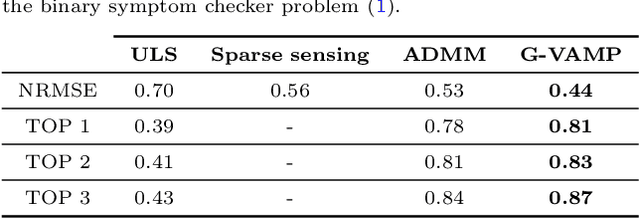

Abstract:Symptom checkers have been widely adopted as an intelligent e-healthcare application during the ongoing pandemic crisis. Their performance have been limited by the fine-grained quality of the collected medical knowledge between symptom and diseases. While the binarization of the relationships between symptoms and diseases simplifies the data collection process, it also leads to non-convex optimization problems during the inference step. In this paper, we formulate the symptom checking problem as an underdertermined non-convex optimization problem, thereby justifying the use of the compressive sensing framework to solve it. We show that the generalized vector approximate message passing (G-VAMP) algorithm provides the best performance for binary symptom checkers.
 Add to Chrome
Add to Chrome Add to Firefox
Add to Firefox Add to Edge
Add to Edge